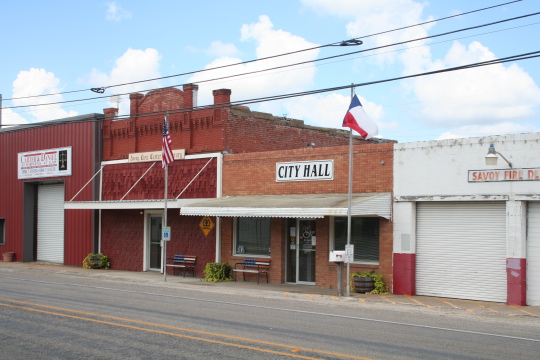
Savoy is located at 33°36′5″N, 96°21′50″W and is at the intersection of U.S. Highway 56 and Farm Road 1752, on the Missouri Pacific line ten miles west of Bonham in extreme west central Fannin County.
Savoy was established about 1863 by Colonel William Savoy, a pioneer settler and landowner who had arrived in the area in the late 1850s. The settlement grew slowly until after the Civil War, when hundreds of settlers began arriving in the area. In 1873 a post office opened.
The Savoy Male and Female College was established in 1876 and was one of the first coeducational academic institutions in North Texas. The school provided educational opportunities regardless of ability to pay tuition for young men and women in the area and Native American students from reservations in Oklahoma. It also offered primary and preparatory classes for county school children.

The Texas and Pacific Railway extended its tracks through the community in the 1870s. With the trade opportunities made possible by the railroad, Savoy became an agricultural shipping center for area farmers, who produced cotton, corn, grain, and numerous other products. In the wake of a May 28, 1880 tornado that killed eleven persons and virtually destroyed the community, Savoy rebuilt and continued to grow and develop. By 1885 it had incorporated, and by the end of the decade the local population had reached 300. By that time Savoy had twenty-five businesses, including several cotton gins, four dry-goods stores, two steam gristmills, two hotels, and a hardware store.

More than 1,000 bales of cotton were shipped from Savoy in 1888. Fire destroyed the Savoy Male and Female College in 1890, but by 1897 the town reported a population of 500, some twenty businesses, three churches, and several public schools. Around this time area farmers shipped some 10,000 bushels of wheat, 7,000 bushels of corn, and perhaps 3,000 bales of cotton annually from Savoy.
The population rose from 343 in 1900 to 400 in 1915 and declined slightly to 378 by the mid-1920s. On the eve of World War I Savoy had some twenty-seven businesses, including a bank and a weekly newspaper; by the end of World War II it had thirteen businesses and 298 residents. The population had increased to 493 by the mid-1960s, and by the mid-1970s it had reached 783, with eleven businesses. By 1990 Savoy reported a population of 877. The population dropped to its current level of 850 in 2000.
Old City Hall Location.
For many years the City of Savoy conducted its business from this building on Hayes Street:

On April 19, 2011, the Savoy City Hall and Police Department moved to their new location in the old medical clinic building on 405 East Hayes Street.
